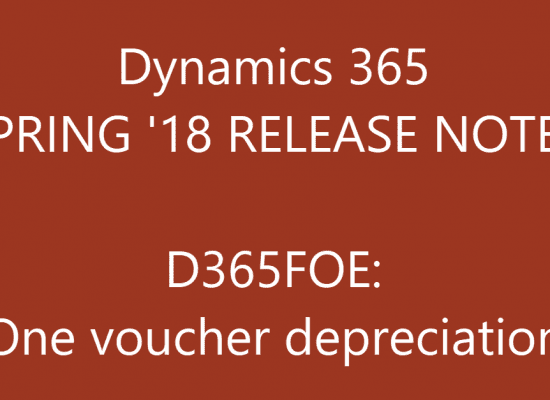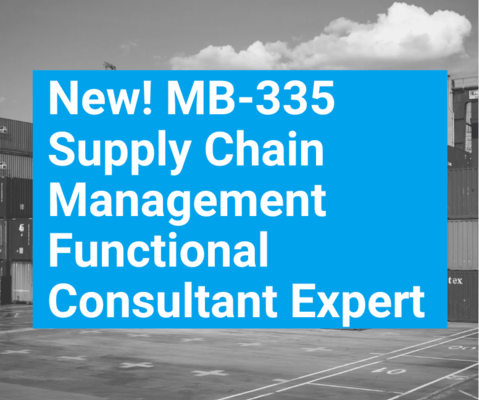Exam MB-700: Microsoft Dynamics 365: Finance and Operations Apps Solution Architect
This preparation guide includes information and tools to assist you in preparation for Exam MB-700: Microsoft Dynamics 365: Finance and Operations Apps Solution Architect
Why get certified in Microsoft Dynamics 365 For Finance and Operations?
Who should take this exam?
Solution Architects for Finance and Operations apps in Microsoft Dynamics 365 are trusted advisors who consult with organizations and implementation team members to refine business needs into a well-defined and cost-effective solution.
A Solution Architect is accountable for the integrity and successful delivery of the complete solution design. The architect provides critical guidance during pre-sales and design and consults throughout the remainder of the project lifecycle to address issues that arise throughout the implementation.
The Solution Architect must have a breadth of knowledge and experience spanning business needs and product capabilities. The Solution Architect must have broad functional and technical expertise as either a Developer or Functional Consultant role in one of the following: Finance, Manufacturing, or Supply Chain Management. In addition, they have extensive domain knowledge in one or more customer industries.
Certification
This exam is part of
Required Exams and Certifications:
-
- Exam MB-700 (this one)
- one of the Associate Certifications
- Microsoft Certified: Dynamics 365 Finance Functional Consultant Associate
- Microsoft Certified: Dynamics 365 Supply Chain Management, Manufacturing Functional Consultant Associate
- Microsoft Certified: Dynamics 365 Supply Chain Management Functional Consultant Associate
- Microsoft Certified: Dynamics 365: Finance and Operations Apps Developer Associate
Preparation options for Exam MB-700
Instructor-led training for MB-700
Live Online Class: MB-700 Apps Solution Architect Exam preparation course
Exam class MB-700: Microsoft Dynamics 365: Finance and Operations Apps Solution Architect
Training manuals for MB-700
- SkillPipe MB-700T00 (Microsoft Official Courseware)
- Additional AXcademy materials
Self-paced training
AXcademy on-demand (coming soon). Sign up for our newsletter to be informed.
Schedule exam
Schedule the exam at Microsoft
More information about D365FO exams
View the complete list of Microsoft Dynamics 365 FO Certification Exams
Skills measured (2021-03-17 update)
Architect solutions (25-30%)
Gather requirements
- identify operational and organizational challenges that impact a business
- identify existing business processes and opportunities to optimize business processes
- gather information about expected transaction volume
- categorize business requirements and perform gap fit analyses
- review and validate business requirements throughout the solution lifecycle
Define the solution architecture
- map business requirements to functional components
- evaluate whether to build versus buy for selected business requirements
- identify opportunities to integrate other Microsoft technologies
- select solution design patterns
- select the appropriate tools to fulfill customer requirements
Describe and document the solution blueprint
- define an organization and organization locations including intercompany information
- document the implementation timeline including roll-out strategies
- define the business process catalog and document solution gaps
- define instances, environments, and solution components
- develop a disaster recovery strategy
- identify required integration and interface details
- define required business intelligence and reporting components
- identify required security roles
Define solution strategies (25-30%)
Select a deployment strategy
- develop a change management and adoption process
- select a deployment model and identify instances and environments required for the
- selected deployment model
- describe the Dynamics 365 One Version strategy and the effects of One Version on solutions
- segment solution development and delivery into logical phases
- provide alternative methodologies and approaches for deploying modifications
- determine solution maintenance cadence and timelines
- identify upgrade scenarios and select appropriate tools
- understanding success by design aspects
Define an application lifecycle management (ALM) strategy
- define a code management and data flow strategy
- define a Power Platform solution management strategy
- determine which build automation capabilities to implement
- define a roll-back strategy for Finance and Operations apps and Power Platform solutions
Determine a data management strategy
- differentiate between transactional and historical data
- define data quality and data validation process
- define data cleansing and transformation strategies
- define data dependencies
- develop a data migration strategy for master, transactional, reference, parameter, and document data entities
- develop data cut-over and data retention plans
Define the security architecture
- differentiate between Azure, Dynamics 365, and infrastructure security
- describe Azure and infrastructure security-related elements
- describe use cases for and capabilities of record-level and role-based security in Dynamics 365
Manage implementations (25-30%)
Describe Lifecycle Services (LCS) tools
- understand the use cases and capabilities of different LCS tools
- understand the use cases and capabilities Business Process Modeler (BPM)
- understand the use cases and capabilities LCS Methodologies
- create a usage profile to describe current or projected usage
- describe uses cases and capabilities for LCS downloadable tools
Manage interactions with FastTrack
- identify the value proposition for FastTrack
- identify FastTrack engagement types and personnel roles
- describe typical FastTrack workshop scoping and the inputs for each workshop
- describe go-live checklist elements
Determine support options
- develop a support plan and strategy
- define post-go-live support plans including response times and service-level agreements (SLAs)
- describe use cases and capabilities for the LCS Support tool
Determine licensing requirements
- determine the types of licenses required
- estimate the number of licenses required by using the License Sizing estimator
- describe the process for estimating ongoing software licensing costs
Manage testing (10-15%)
Define a testing strategy
- define a regression testing strategy
- identify opportunities for automated testing
- review use cases and test coverage for all scenarios
- determine when to use RSAT versus SysTest framework versus Postman versus ATL and other tools
Define a performance testing strategy
- define performance goals and requirements
- identify performance monitoring and testing tools
- define performance benchmarks and success criteria
- design a performance and load testing strategy
- troubleshoot performance issues
Skills measured – older versions
Skills measured – valid until 2021-03-16
NOTE: The bullets that appear below each of the skills measured are intended to illustrate how Microsoft is assessing that skill. This list is not definitive or exhaustive.
NOTE: In most cases, exams do NOT cover preview features, and some features will only be added to an exam when they are GA (General Availability).
Identify solution requirements (30-35%)
Identify business requirements
- describe an organization including companies, divisions, and other entities
- visualize and map an organizational structure, identify reporting requirements, including operational, analytical, and externally facing reports
Perform gap analyses
- categorize business requirements to determine what gaps exist between current apps and services and the proposed future-state solution
- identify the business processes that must be added, removed, or modified to meet the achieve goals
Define compliance requirements
- define audit requirements
- determine localization requirements and design a localization strategy
- identify regulatory and governmental compliance requirements, including data privacy regulations
Define security requirements
- design a strategy for segregating duties
- design the security strategy and architecture for a solution
Determine licensing needs and costs
- estimate the costs and highlight the benefits of each solution option
- determine licensing requirements for Finance and Operations apps and third-party apps and services
- estimate upfront and ongoing infrastructure and cloud services costs
- estimate the long-term costs for a solution
Design solution components (40-45%)
Design business processes
- identify use cases and business optimization opportunities, including upgrade and data migration scenarios
- map requirements and business process steps to a solution
- select solution components for each functional area
Design data management and migration strategies
- identify and characterize data sources that must be migrated
- design a master data management strategy, including but not limited to Azure Data Lake or Data Migration Framework (DMF, DIXF)
- develop a data migration strategy
- develop a data cut-over plan
Design system integrations
- identify opportunities to increase return on investment by integrating Office 365 apps and services, Customer Insights, other related applications, and other Microsoft solutions, including Power Platform services
- identify options for integrating with third-party solutions
- select integration strategies
- recommend add-on technologies and services
Design solution infrastructure
- select a cloud-based or on-premises implementation
- identify required infrastructure apps, services, components, and features
- define performance requirements
Define solution testing and management strategies (25-30%)
Develop an application lifecycle management (ALM) strategy
- identify the available instance types
- select instance types for a solution
- identify use cases, integration points, and methodologies for implementing Azure DevOps functionality
Recommend Lifecycle Services (LCS) tools
- identify the available LCS tools, including Business Process Modeler (BPM), Regression Suite Automation Tool (RSAT) and Regulatory Updates
- select the appropriate LCS tools to support a solution implementation
Define a testing strategy
- design a strategy for performance and load testing
- define a regression testing strategy, including what requires testing and the order of testing
- determine when to use RSAT, SysTest, and other tools and technologies
- define performance goals and requirements, predict transaction volumes
Skills measured – valid until 2020-09-28
This exam measures your ability to accomplish the technical tasks listed below. The percentages indicate the relative weight of each major topic area on the exam. The higher the percentage, the more questions you are likely to see on that content area on the exam. Please note that the questions may test on, but will not be limited to, the topics described in the bulleted text.
Overview:
-
- Identify Solution Requirements (30-35%)
- Design Solution Components (40-45%)
- Define Solution Testing and Management Strategies (25-30%)
Details:
Identify Solution Requirements (30-35%)
Identify business requirements
- describe an organization including companies, divisions, and other entities
- visualize an organization structure
- identify reporting requirements, including operational, analytical, and externally facing reports
Perform gap analyses
- categorize business requirements and determine what gaps exist between current apps and services and the proposed solution
- identify the functional business processes that must be added, removed, or modified
Define compliance requirements
- define audit requirements
- determine localization requirements and design a localization strategy, including taxes and user interfaces
- identify regulatory and governmental compliance requirements, including data privacy regulations
Define security requirements
- design a strategy for segregating duties
- design the security strategy and architecture for a solution
Determine licensing needs and costs
- evaluate the costs and benefits of solution options
- determine licensing requirements for Dynamics 365 for Finance and Operations and third-party apps and services
- estimate upfront and ongoing infrastructure and cloud services costs
- estimate the long-term costs for a solution
Design Solution Components (40-45%)
Design business processes
- identify use cases and business optimization opportunities, including upgrade and data migration scenarios
- map requirements and business process steps to a solution
- select solution functional components
Design data migration strategies
- identify and characterize data sources that must be migrated
- design a master data management strategy
- develop a data migration strategy
- develop a data cut-over plan
Design system integrations
- identify options to increase return on investment by integrating Office 365 apps and services and other Microsoft solutions
- identify options for integrating with third-party solutions
- select integration strategies
- recommend add-on technologies and services
Design solution infrastructure
- select a cloud-based or on-premises implementation
- identify required infrastructure apps, services, components, and features
- define performance requirements
Define Solution Testing and Management Strategies (25-30%)
Develop an application lifecycle management (ALM) strategy
- identify the available instance types
- select instance types for a solution
- identify use cases, integration points, and methodologies for implementing Azure DevOps functionality
Recommend Lifecycle Services (LCS) tools
- identify the available LCS tools, including Business Process Modeler (BPM), Regression Suite Automation Tool (RSAT) and Regulatory Updates
- select LCS tools to support a solution
Define a testing strategy
- design a strategy for performance and load testing
- define a regression testing strategy, including what requires testing and the order of testing
- determine when to use RSAT, SysTest, and other tools and technologies
- define performance goals and requirements, predict transaction volumes


